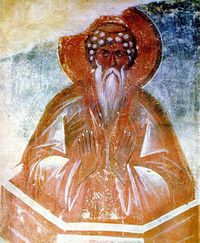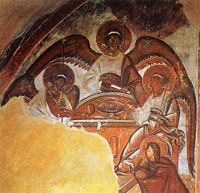Teofan Grecul
Teofan Grecul, (ru. Феофан Грек, gr. Θεοφάνης) a fost unul din cei mai importanți iconografi ai Bisericii Ortodoxe Ruse. A trăit în secolul al XIV-lea și a fost profesorul lui Andrei Rubliov. A fost descris de Epifanie cel Înțelept[1] ca fiind un renumit om înțelept, filosof versat, faimos artist creator de cărți și cel mai bun iconograf al timpului său în Rusia.
Cuprins
Viața
Teofan era grec de origine, de unde și supranumele de „Grecul”. S-a născut probabil la Constantinopol către anul 1340, deși unele surse consideră că s-ar fi născut în Creta. Se cunosc puține lucruri despre el înainte de aveni în Rusia, dar probabil că a învățat și apoi dezvoltat arta iconografică la Constantinopol. Mai apoi a lucrat ca iconograf în Crimeea. Niciuna din icoanele sau frescele sale din aceste perioade nu s-a păstrat sau nu este cunoscut să se fi păstrat până astăzi.

His frescos survive now only in the Church of Our Savior of the Transfiguration-in-Elijah Street in Novgorod. He has been noted for his style of painting from inspiration and not copying from prototypes. His style is considered unsurpassed in expression achieved by almost mono-colored painting. His paintings have great intensity that captures the spiritual essence of each figure. Among the best preserved images in the church are the magnificent image of the Pantocrator in the dome, the frescos of the Forefathers Noah, Melzhizedek, and Seth and the panel icon of the Old Testament Trinity.
Theophan worked swiftly and did not use pattern books. He did not mind spectators. His figures tended to be very tall and severe, with dark faces and long, thin arms. The mystical elements in his paintings are believed to reflect the influence of Hesychasm. Some of his contemporaries noted that he appeared to be "painting with a broom", in reference to the bold, broad execution in some of his finest frescos, which are unique in the larger late Greek tradition. At the request of Epiphanius the Wise, Theophan produced a miniature for a Gospels manuscript showing a view of Hagia Sophia in Constantinople and the statue of Justinian I to the south of the cathedral.
Theophon is noted also to have painted panel icons, but in recent academic debate his authorship of many of these icons have been questioned.
The date of his repose is uncertain, but it is believed to be about the year 1408 to 1410.
Surse
- w:Theophanes_the_Greek
- Backwell: Theophan the Greek
- Theophanes the Greek
- Theophanes The Greek
- Theophanes The Greek
- Theophanes The Greek
- V. Bulkin, trans. Y. Pamfilov, Novgorod, Aurora Art Publishers, Leningrad, 1984
Legături externe
Note
- ↑ Epifanie cel Înțelept (ru. Епифаний Премудрый) a fost un călugăr rus de la sfârșitul secolului al XIV-lea și începutul secolului al XV-lea, important scriitor în vremea înfloririi spirituale și culturale din Rusia. Epifanie a fost ucenic al sfântului Serghie de Radonej și un admirator al lui Teofan Grecul.
